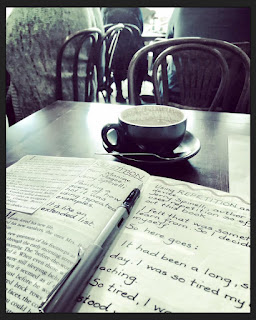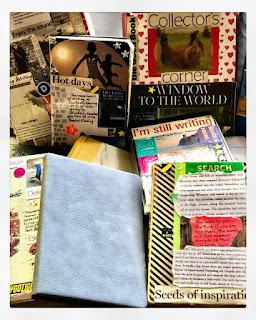Writer's Notebooks -Avoiding A Few Hazards
Writer Joan Didion famously said our (writer’s) notebooks give us away. We are revealed by the contents. Our notebooks are a place to collect, then take those collected items and use them to spark further original writing. As Ralph Fletcher, writer and educator reminds us, we use our notebooks to breathe in (collect) and breathe out (generate).With these thoughts ringing in my ears, I envisage notebooks brimming with words and ideas across a range of subjects and genres. The notebook is a place to experiment, take risks, make important discoveries, or excavate memories and ideas from deep within. It can be a place to have fun with words.
So why is it that in some classrooms when students take out their notebooks the pages reveal a picture far removed from the images I just outlined? Why does one get the impression that the notebook in these school settings is only realizing a small part of its potential?
Why is the critical ingredient –‘writing,’ so lacking as to be almost missing in action? Content is so critical to the developing writer and yet the writer’s notebooks in these contexts, lack integrity because they’re not being used to generate authentic writing.
What does one see frequently documented in these notebooks? Well, usually it’s limited to such entries as pictures, artifacts, lists, Y charts, plans, graphic organizers, but little genuine writing! A closer examination of the few notebook entries reveals the sad fact that the entire class is frequently writing about the one same topic in exactly the same way. The teacher’s topic continues to reign supreme! The notebooks are teacher controlled. When teachers descend upon student notebooks the notebook owner begins to see it as just another workbook. Integrity fades. The unique status of the notebook evaporates. Risk taking, experimenting, shrink away, replaced by teacher pleasing and the slide towards safe writing.
In such a context the writer’s notebook takes on the appearance of a stage managed planning book, rather than a place to write. Some student notebooks look like scrapbooks, and it is obvious that ‘writing’ is not the major focus of these stylized, overly managed creations.
The name says it all really- it’s a writer’s notebook. It may contain elements of scrapbooks, sketchbooks, diaries, or journals, -but in the end it is the writing that remains the critical component. Notebooks should contain lots of 'beginnings.' The launching of raw words and initial drafts should sit comfortably among the lists, quotes, extracts and other brief entries. It is in the rereading of these starting pieces that longer writing projects begin to reveal themselves. The writer makes decisions regarding which entries deserves to be lifted from the notebook and further developed.
I could espouse a theory as to why this situation has developed, but I want to focus on possible solutions rather than further examination of the problem at this time. So,
· How do we maximize the potential of the writer’s notebook?
· How do we improve the situation for student writers and their teachers?
The following actions help preserve the integrity of the writer's notebook:
- Increased professional reading about writing. Books such as Ralph Fletcher’s Breathing In, Breathing Out, Keeping A Writer’s Notebook, or Aimee Buckner’s, ‘Notebook Knowhow’ provide a great insight into using notebooks. In order to teach writing effectively, we must grow our knowledge of how writing happens.
- Increased use of the writer’s notebook by teachers. We learn by doing. For the notebook to be truly impactful, it requires teachers willing to embrace it. --Risk taking educators who lead the way forward for impressionable young writers seeking direction. The notebook is not just another thing we make students do.
- The best way to influence a child’s view of their notebook is for a teacher to attend to their own notebook. Make a powerful declaration by regularly sharing entries from your own notebook. Sharing notebook entries provides further insight as to how a notebook might look. Let the sharing begin!
- Strengthen the reading writing links. Embrace literature as a tool for teaching writing. Teachers of writing are not alone. Mentors await discovery. Teach mindfully into these collaborations.
- Teach students how to harvest ideas for writing. This requires the teacher to discover where ideas reside and then share this vital understanding with student writers. A simple place to start is your own life, books, places, people, pictures, photographs, media, events, your local environment…
- Allow students choice in the configuration of their notebooks. One size doesn’t fit all. Notebooks of various sizes suit various situations, various needs. Some students may prefer electronic notebook formats.
- Use the notebook to make lots of ‘starts’ before choosing one special piece that may be lifted out of the notebook and developed further. The inexperienced writer needs to see this enacted by a proficient writer.
- Encourage the notion of the notebook as a place for the writer to experiment, collect, ask questions and wonder through writing.
- Show students writers how to fill the pages of their notebooks with words and ideas. Allow them follow your lead as a joyfully literate educator.
- Encourage students to take their notebooks out into the world beyond their classroom. Set the notebooks free! Elevate the notebook to a position where it has integrity beyond the status of a 'workbook.'
How the notebook is perceived by both teachers and students is a critical consideration in establishing how it is viewed over time. It is not the role of the educator to tame the words that enter a young writer’s notebook. The notebook should at all times remain a slightly wild place for a writer to work with words.
Encourage student writers to roam the literary terrain in search of words and ideas, discoveries and the inspiration to write in that space. Preserve a view of the notebook as a place to explore possibilities.
We can influence the attitudes of our student writers, through our own actions, that the notebook they own is hungry to receive their words.
Let’s remove the unnatural impediments to writing. Teach into the notebook through our own actions as writers and teachers. Then watch the writing take off and the notebook realize its true potential as a resource; a writing tool.








Comments
Post a Comment